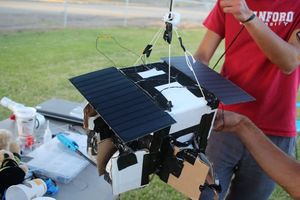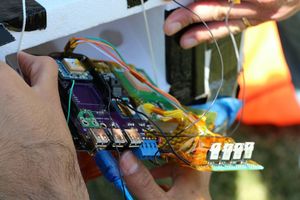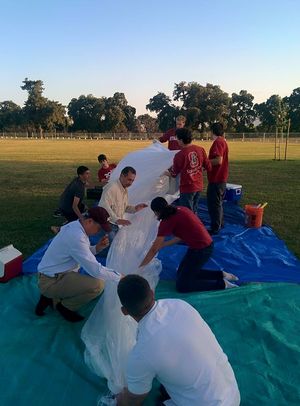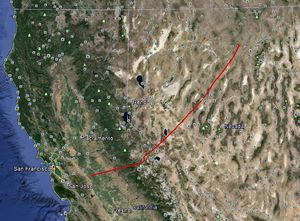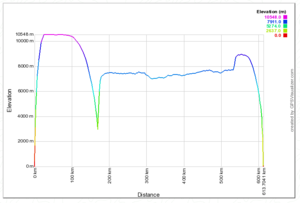Difference between revisions of "SSI-20"
Stanfordssi (talk | contribs) |
Stanfordssi (talk | contribs) |
||
| (3 intermediate revisions by the same user not shown) | |||
| Line 2: | Line 2: | ||
| header = SSI-20 | | header = SSI-20 | ||
| img link = File:rsz_11ssi_19.png | | img link = File:rsz_11ssi_19.png | ||
| − | | launch date = May 16th 2015, | + | | launch date = May 16th 2015, 7:39 PM PDT |
| launch site = Laird Park, Modesto, CA | | launch site = Laird Park, Modesto, CA | ||
| launch coordinates = 37.56158, -121.14993 | | launch coordinates = 37.56158, -121.14993 | ||
| Line 40: | Line 40: | ||
Miraculously, after maintaining its position on the cliffside for about 15 minutes, the balloon began to ascend to an altitude of about 24,000 ft, which it maintained for most of the remainder of the mission duration. We maintain that the balloon dislodged ballast while being on the cliffside, causing additional free lift and consequent ascent. However, at some point during the morning, the balloon began another steady ascent cycle. Weather reports suggest that the balloon flew into a thunderstorm, being lifted rapidly by an updraft. The balloon rose very quickly, overshooting its target altitude and rebounding with a steep descent cycle. It finished its flight with a landing in Northeast Nevada. | Miraculously, after maintaining its position on the cliffside for about 15 minutes, the balloon began to ascend to an altitude of about 24,000 ft, which it maintained for most of the remainder of the mission duration. We maintain that the balloon dislodged ballast while being on the cliffside, causing additional free lift and consequent ascent. However, at some point during the morning, the balloon began another steady ascent cycle. Weather reports suggest that the balloon flew into a thunderstorm, being lifted rapidly by an updraft. The balloon rose very quickly, overshooting its target altitude and rebounding with a steep descent cycle. It finished its flight with a landing in Northeast Nevada. | ||
| − | + | <gallery widths=300px heights=300px> | |
| − | + | File:Ssi20gt.jpg | <center> SSI-20 Flight Path </center> | |
| + | File:Ssi20alt.png | <center> SSI-20 Flight Profile </center> | ||
| + | </gallery> | ||
== Debriefing == | == Debriefing == | ||
Latest revision as of 05:56, 18 October 2015
| SSI-20 | ||||
|---|---|---|---|---|
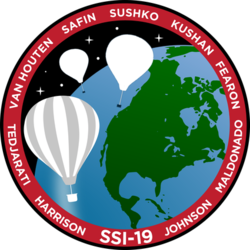
| ||||
| Launch date | May 16th 2015, 7:39 PM PDT | |||
| Launch site | Laird Park, Modesto, CA | |||
| Launch coordinates | 37.56158, -121.14993 | |||
| Flight duration | 16 hrs | |||
| Landing coordinates | 37.5617, -121.1506 | |||
| ||||
SSI-20 was the 20th launch of SSI Balloons. It was the first zero pressure balloon launch by SSI. SSI-20 managed to stay aloft for 16 hours, breaking SSI's previous record of longest time aloft (by SSI-19), and also set the record for longest ground track by achieving a distance of 613km from launch site. It also had a unique launch pattern that featured an overshooting of altitude and failure of ballast-release mechanisms, that was followed by a landing, dislodging of ballast, and re-ascent and consequent equilibration.
Flight Profile
SSI-20 featured a zero pressure balloon (ZPB) donated by CNSP with an approximate volume of 902 cubic feet and a weight of 1.67 kg. The goal for SSI-20 was to test the possibility of ZPB's for long-duration flights in future SSI missions, as well as try to reach as long a ground-track and time-aloft as possible. CNSP helped to fill the ZPB with the appropriate amount of helium using their mass-flow meter, allowing for the precise fill of 300 cubic feet of helium.
Payload Specifications
The SSI-20 payload used SSI's older Gen 2 Avionics with an added circuit for ballast deployment controls. The payload itself weighed a total of 4.36 kg. The sides of the payload box contained rolled-up bags filled with sand to be used as ballast. These bags were rolled up and held in this position using a tied fishing line. The fishing line was then fastened to a loop of nichrome wire, which when activated would slice through the fishing line, unroll the bag, and allow the sand to disperse and drop from the payload. There were four bags of sand ballast, each of which was incrementally smaller in weight and dropped 10% of total balloon + payload mass to compensate for gas contraction and lift loss during nights.
Launch site
The launch was conducted at Laird Park, just west of Modesto, CA, a site frequented by the balloons team. The team left campus at 10 am, arriving just after 11:30 am. The payload was double-checked for flight fidelity, and adjustments were made in the cardboard side-panels that kept the ballast bags from dumping sideways. After these were reinforced, satellite communications were tested, and code in charge of ballast drop was verified for functionality.
Filling of the ZPB started at approximately 6:30 pm and concluded at around 7:30 pm. It took a total of nine SSI members to maintain control of the balloon in the face of winds and prevent premature release. It was launched shortly after 7:30 pm. It was over-filled for the purpose of ascending to a high altitude in minimum time (to avoid low-lying air traffic). This balloon was designed for flight in the jet stream at an altitude of 35,000 feet. Due to this, SSI was in contact with Oakland TRACON for the entire duration of the mission, giving position and altitude updates every 10-15 minutes as the balloon flew eastward.
The Flight
The balloon began with a very fast ascent rate, rising to an altitude of approximately 34,600 feet (within 400 feet of expected altitude) within less than an hour. The balloon equilibrated at this altitude and maintained this altitude until it was about 100 km from the launch site. It then began a shallow descent (~ 1 m/s) over Yosemite National Park, and landed on a cliffside at an altitude of 10,000 ft. We attribute this to a failure to drop ballast as the night dawned - contracting the gas and causing a descent.
Miraculously, after maintaining its position on the cliffside for about 15 minutes, the balloon began to ascend to an altitude of about 24,000 ft, which it maintained for most of the remainder of the mission duration. We maintain that the balloon dislodged ballast while being on the cliffside, causing additional free lift and consequent ascent. However, at some point during the morning, the balloon began another steady ascent cycle. Weather reports suggest that the balloon flew into a thunderstorm, being lifted rapidly by an updraft. The balloon rose very quickly, overshooting its target altitude and rebounding with a steep descent cycle. It finished its flight with a landing in Northeast Nevada.
Debriefing
SSI-20, overall, was a successful pilot program of ZPB's for SSI. Despite a failure in ballast dropping, the balloon broke many SSI records.
- The balloon failed to drop ballast as intended when it began descent. This can either be attributed to failure within the avionics, or, moreso, potential freezing or icing of the plastic ballast bags and sand. If there was icing on the ballast bags, nichrome deployment would not cause any ballast drops.
- Zero Pressure balloon dynamics are very sensitive, with a small updraft causing an overshot and consequent descent in the latter portion of the flight. Precise control of ZPB's is challenging.
Milestones
- Longest flight of SSI Balloons (as of May 17, 2015)
- Longest ground track of SSI Balloons (as of May 17, 2015)
| Balloon Launches | |
|---|---|
| 2014-15 | SSI-19 • 20 • 21 • 22 |
| 2015-16 | SSI-23(a) • 24 • 25 • 26 • 27 • 28 • 29 • 30 • 31 • 32 • 33 • 34 • 35 • 36 • 37 • 38 • 39 • 40 • 41 • 42 • 43 |
| 2016-17 | 44 • 45 • 46 • 47 • 48 • 49 • 50 • 51 • 52 |
| 2017-18 | |
| 2018-19 | 83 • 86 • 87 • 90 • 91 |
| 2019-20 | 92 • 93 • 97 |
| V • E | |
